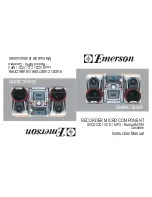
18
CLEAR COM
INTERFACE
The Clear Com production intercom system is the de-facto standard within the music
industry. The SR40·8 has an integral Clear Com interface that emulates a standard belt
pack and ties it into the console’s headphone system. To use it, you use the console’s
talkback microphone and the solo system headphones. The interface provides the
standard Clear Com beltpack features: call button, call light, receive level control, and
push-to-talk switch. Of course, like any Mackie product, there’s some new thinking going
on to make your life easier.
One major problem for any intercom system is the possibility of a ground loop between
the audio console’s ground system and whatever ground the production intercom
system is using. In many situations, the stage lighting company provides the intercom. In
this case, the intercom system ground is most likely the same as the dimmer rack’s (nasty,
really nasty). It is best if this ground not come in contact with the audio console’s
ground.
The SR40·8’s Clear Com interface uses an isolation transformer to keep the two ground
systems completely separate. There is no possibility of a ground loop regardless of who
supplies the intercom system and where they get their ground from.
CIRCUIT DESCRIPTION
(Refer to the MASTER PCB schematic.)
The Clear Com intercom system uses a standard microphone cable as its means of
interconnection. Signal levels are low enough that the system can use a spare mic line in
the microphone snake. The three wires of the mic cable are used for: pin 1 - ground, pin
2 - 28V dc power, pin 3 audio. This is a party-line intercom system since all talkers and all
listeners share the same line. All stations are connected in parallel. The DC voltage on
pin 2 supplies power for the entire system. Any station can talk and any station can
listen. The system uses a low voltage DC signal applied to the audio line for signaling. A
simple darlington transistor switch monitors the DC conditions on the line and turns on a
light bulb when it detects a call signal.
One other competing intercom system, pioneered by RTS Systems (now a division of
Telex), uses a balanced line for the audio signal with the audio modulated onto the
power supply voltage. Ultrasonic tones provide addressable signaling. This system has
found a home within the broadcast and video production fields. The two systems are
not compatible without use of a special interface system.
















































